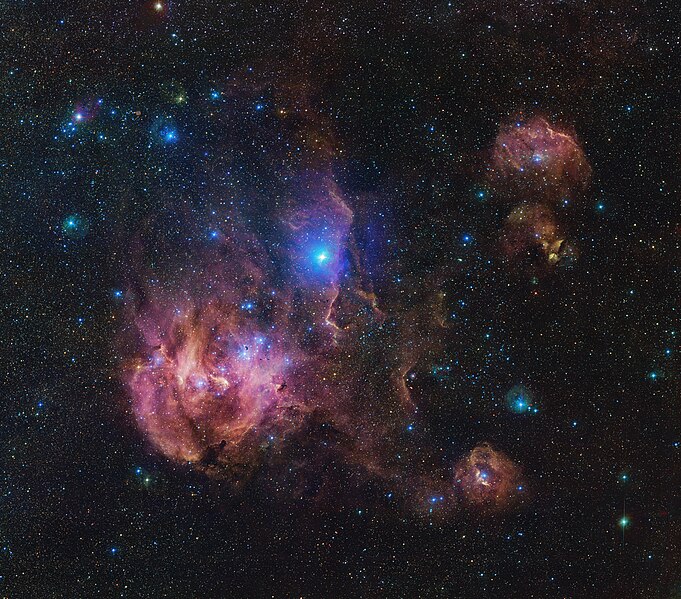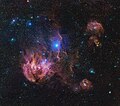File:Running Chicken Nebula - Eso2320a.jpg

Original file (42,057 × 37,010 pixels, file size: 733.72 MB, MIME type: image/jpeg)
Captions
Captions
Summary[edit]
| DescriptionRunning Chicken Nebula - Eso2320a.jpg |
English: The Running Chicken Nebula
Wispy pink clouds pop out of a dark background. The brightest and largest cloud is offset from centre to the lower left. A cloud ridge cuts vertically through the centre of the frame, with a large bright blue-white spot in the middle. To the right of the image are three smaller clouds. Dotted across the image are blue, orange and white points of varying size and brightness. The Running Chicken Nebula comprises several clouds, all of which we can see in this vast image from the VLT Survey Telescope (VST), hosted at ESO’s Paranal site. This 1.5-billion pixel image spans an area in the sky of about 25 full Moons. The clouds shown in wispy pink plumes are full of gas and dust, illuminated by the young and hot stars within them. Credit: ESO/VPHAS+ team. Acknowledgement: CASUDeutsch: Der Nebel des Laufenden Huhns
Zarte rosa Wolken heben sich von einem dunklen Hintergrund ab. Die hellste und größte Wolke ist von der Mitte nach unten links versetzt. Ein Wolkenstreifen verläuft vertikal durch die Mitte des Bildes, mit einem großen, hellen blau-weißen Fleck in der Mitte. Auf der rechten Seite des Bildes befinden sich drei kleinere Wolken. Über das Bild verteilt sind blaue, orangefarbene und weiße Punkte von unterschiedlicher Größe und Helligkeit. Der Running Chicken (Laufendes Huhn)-Nebel besteht aus mehreren Wolken, die wir alle auf diesem riesigen Bild des VLT Survey Telescope (VST) sehen können, das am ESO-Standort Paranal betrieben wird. Dieses 1,5-Milliarden-Pixel-Bild überspannt ein Gebiet am Himmel, das etwa 25 Vollmonden entspricht. Die Wolken, die in zarten rosafarbenen Schwaden dargestellt sind, sind voller Gas und Staub, die von den jungen und heißen Sternen in ihnen beleuchtet werden. Herkunftsnachweis: ESO/VPHAS+ team. Acknowledgement: CASUEspañol: Con sus espectaculares brazos brillantes, las enormes galaxias espirales parecen acaparar toda nuestra atención, pero NGC 6822, una galaxia enana irregular barrada, demuestra que las galaxias espirales no tienen el monopolio de la belleza galáctica. También conocida como galaxia de Barnard, NGC 6822 se encuentra en la constelación de Sagitario, a solo 1,6 millones de años luz de distancia, y está llena de regiones de abundante formación estelar.
Esta nueva imagen es una composición formada por observaciones anteriores hechas con el instrumento Wide Field Imager, instalado en el Telescopio MPG/ESO de 2,2 metros en el Observatorio La Silla de ESO, y los nuevos datos recogidos por ALMA (Atacama Large Millimeter/submillimeter Array). Las áreas observadas con ALMA se destacan en la imagen y pueden verse aquí en detalle. Las observaciones de ALMA revelan, con una resolución sin precedentes, la estructura de las nubes de gas en las que se están formando estrellas. Observaciones realizadas en nuestra propia Galaxia han demostrado que las estrellas se forman en los núcleos densos de nubes gigantes de gas de hidrógeno molecular, los únicos lugares donde el gas puede llegar a ser lo suficientemente frío como para colapsar bajo su propia gravedad. Estas condiciones también fomentan la formación de otras moléculas como monóxido de carbono, una herramienta indispensable para ayudar a los astrónomos a detectar el gas de hidrógeno molecular galáctico. Hasta hace poco, los astrónomos sólo habían sido capaces de resolver las regiones de formación estelar que están dentro de la Vía Láctea, pero ahora, la aguda vista de ALMA nos permite estudiar la formación de estrellas en otras galaxias. El análisis de los datos reveló que, a diferencia de lo que ocurre en nuestra propia galaxia, las moléculas observadas se concentran en pequeños y densos núcleos de gas. Esto explica por qué, hasta ahora, ha sido tan difícil observar las regiones de formación estelar extragalácticas, especialmente en galaxias de baja masa y baja metalicidad. ALMA también descubrió que los núcleos en NGC 6822 se comportan de formas bastante parecidas a las guarderías estelares que hay en la Vía Láctea, lo que indica que la física de formación de estrellas en estas galaxias de baja masa se asemejan a lo que vemos en nuestra propia galaxia.Español: La Nebulosa del Pollo Corredor
La Nebulosa del Pollo Corredor La Nebulosa del Pollo Corredor está compuesta por varias nubes y podemos verlas todas en esta inmensa imagen del VLT Survey Telescope (VST), que se encuentra ubicado en el Observatorio Paranal de ESO. Esta imagen de 1.500 millones de píxeles abarca un área en el cielo de aproximadamente 25 lunas llenas. Las nubes que se muestran como tenues penachos rosados están llenas de gas y polvo, iluminadas por las estrellas jóvenes y calientes que hay en su interior. Crédito: ESO/VPHAS+ team. Acknowledgement: CASU |
| Date | |
| Source | https://www.eso.org/public/images/eso2320a/ |
| Author | ESO/VPHAS+ team. Acknowledgement: CASU |
Licensing[edit]
 |
This media was created by the European Southern Observatory (ESO).
Their website states: "Unless specifically noted, the images, videos, and music distributed on the public ESO website, along with the texts of press releases, announcements, pictures of the week, blog posts and captions, are licensed under a Creative Commons Attribution 4.0 International License, and may on a non-exclusive basis be reproduced without fee provided the credit is clear and visible." To the uploader: You must provide a link (URL) to the original file and the authorship information if available. |
This file is licensed under the Creative Commons Attribution 4.0 International license.
| |
File history
Click on a date/time to view the file as it appeared at that time.
| Date/Time | Thumbnail | Dimensions | User | Comment | |
|---|---|---|---|---|---|
| current | 00:19, 24 December 2023 |  | 42,057 × 37,010 (733.72 MB) | Fabian RRRR (talk | contribs) | Full resolution |
| 00:11, 24 December 2023 |  | 4,000 × 3,520 (6.73 MB) | Fabian RRRR (talk | contribs) | == {{int:filedesc}} == {{Information |description={{en|1=The Running Chicken Nebula Wispy pink clouds pop out of a dark background. The brightest and largest cloud is offset from centre to the lower left. A cloud ridge cuts vertically through the centre of the frame, with a large bright blue-white spot in the middle. To the right of the image are three smaller clouds. Dotted across the image are blue, orange and white points of varying size and brightness. The Running Chicken Nebula comprise... |
You cannot overwrite this file.
File usage on Commons
There are no pages that use this file.
File usage on other wikis
The following other wikis use this file:
Metadata
This file contains additional information such as Exif metadata which may have been added by the digital camera, scanner, or software program used to create or digitize it. If the file has been modified from its original state, some details such as the timestamp may not fully reflect those of the original file. The timestamp is only as accurate as the clock in the camera, and it may be completely wrong.
| Credit/Provider | ESO/VPHAS+ team. Acknowledgement: CASU |
|---|---|
| Source | European Southern Observatory |
| Short title |
|
| Image title |
|
| Usage terms |
|
| Date and time of data generation | 14:00, 21 December 2023 |
| Software used | Adobe Photoshop 24.7 (Windows) |
| File change date and time | 14:21, 11 December 2023 |
| Date and time of digitizing | 19:09, 31 August 2023 |
| Date metadata was last modified | 15:21, 11 December 2023 |
| Unique ID of original document | xmp.did:d0cc9beb-c8e7-164c-86e2-b25b5feb8738 |
| Keywords |
|
| Contact information |
Karl-Schwarzschild-Strasse 2 Garching bei München, None, D-85748 Germany |
| IIM version | 4 |